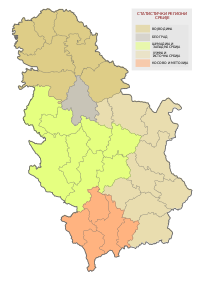
Photo from wikipedia
ETHNOPHARMACOLOGICAL RELEVANCE River and mountain regions in Eastern and South-Eastern Serbia are geographically interesting and, historically they represent an important resource of plants used as food, spices and as remedies… Click to show full abstract
ETHNOPHARMACOLOGICAL RELEVANCE River and mountain regions in Eastern and South-Eastern Serbia are geographically interesting and, historically they represent an important resource of plants used as food, spices and as remedies for treating many diseases. Different cultures have lived in these regions for ages. They have used wild plants and the methods of their preparation and application, which has remained throughout the history and now is passed on from generation to generation. The aim of the study is a survey of herbal drug uses for the specific ailment categories and their comparison between the two research regions. METHODS Semi-structured anonymous ethnobotanical interviews were conducted. The interviews took place in the River Timok region and Mountain Svrljig region as they make two of the most interesting centers of plant biodiversity. Volunteers in the Timok region were 64 median age and in the Svrljig region - 73 median age. People were interviewed about the local names of plants, the preparation process and about which disease the plants were used for. RESULTS and Discussion: 161 respondents from 10 Timok and 10 Svrljig municipality villages were interviewed and 2,199 use-reports were recorded. The results of the ethnobotanical research showed 195 plant taxa from the Timok and Svrljig regions. In the Timok region, the recorded species were classified into 47 families and in the Svrljig region they were classified into 64 families. Out of 195 taxa used for medicinal purposes, only 52 species are also included in the European Pharmacopoeia 9.0. The most commonly used plants in Timok region were Hypericum spp., Matricaria chamomilla, Mentha x piperita, Urtica dioica, Juglans regia, while the residents of Svrljig region most frequently used Satureja montana, Sambucus nigra, Polygonum aviculare, Marrubium vulgare and Teucrium chamaedrys. Different statistical analyzes showed that Vlachs used more medical specimens per person than Serbs in the Timok region. The study demonstrated that female informants treated more body organs with medical species per person than male informants. There was a significant difference between the male and and female respondents of the Svrljig region in terms of organ systems for which they used certain plant species. CONCLUSION The ethnopharmacological study showed a great importance of medicinal plants in the daily life of local communities. According to the analysis, it can be concluded that the village population of the Timok and Svrljig regions use medicinal plants to treat digestive tract problems rather than seeking professional medical attention in health facilities. The aerial part and rhizome of Elymus repens are used for digestive problems in both the Timok and Svrljig regions, and the use of this plant in for the treatment of digestive tract problems is not mentioned in the similar studies conducted in the Balkan region. Also, it can be observed that the population of the two different regions mainly use different herbal drugs to treat the same systems. The reason for that is the availability of certain plants that grow in the two different areas - river and mountain area.
Journal Title: Journal of ethnopharmacology
Year Published: 2020
Link to full text (if available)
Share on Social Media: Sign Up to like & get
recommendations!